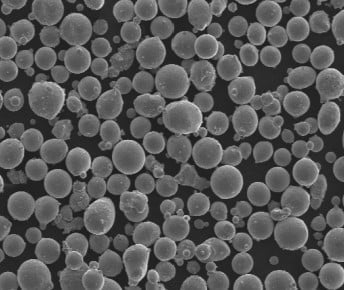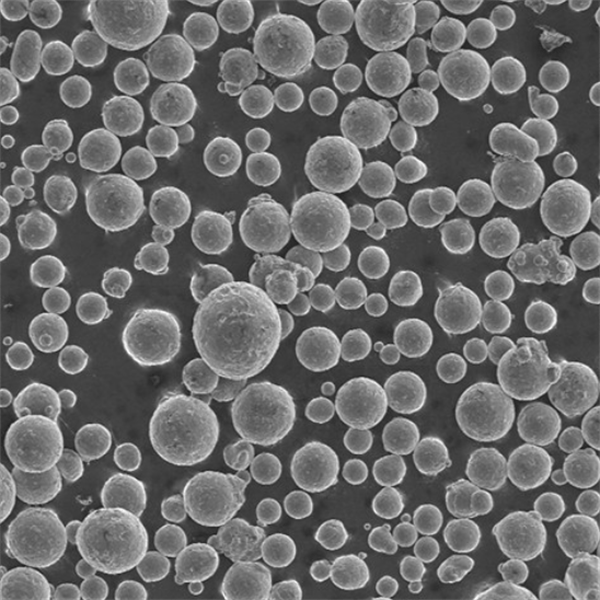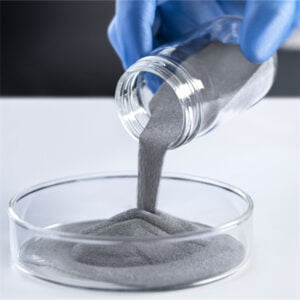Próżniowe topienie indukcyjne
Spis treści
Przegląd
Próżniowe topienie indukcyjne (VIM) to zaawansowany i wysoce precyzyjny proces wykorzystywany do produkcji wysokiej jakości stopów metali i proszków. Metoda ta ma kluczowe znaczenie dla zastosowań wymagających wyjątkowej czystości i precyzyjnego składu, dzięki czemu jest niezbędna w branżach takich jak lotnictwo, urządzenia medyczne i inżynieria o wysokiej wydajności. Zagłębmy się w zawiłości VIM, badając jej procesy, zastosowania, zalety, wady i szczegółowe informacje na temat różnych modeli proszków metali wytwarzanych tą techniką.
Co to jest topienie próżniowe?
Indukcyjne topienie próżniowe polega na topieniu metali w środowisku próżniowym z wykorzystaniem indukcji elektromagnetycznej. Technika ta minimalizuje skażenie gazami i zanieczyszczeniami, zapewniając produkcję metali o doskonałej czystości i jednorodności. Topiąc metale w próżni, VIM zapobiega utlenianiu i umożliwia precyzyjną kontrolę nad składem produktu końcowego.
Kluczowe szczegóły VIM:
- Proces: Topienie metali za pomocą indukcji elektromagnetycznej w próżni.
- Cel: Produkcja stopów i proszków metali o wysokiej czystości.
- Zastosowania: Lotnictwo i kosmonautyka, urządzenia medyczne, wysokowydajna inżynieria.

Jak działa próżniowe topienie indukcyjne?
Wyobraź sobie zaawansowaną technologicznie kuchnię, w której gotujesz swoje ulubione danie w doskonale kontrolowanym środowisku, wolnym od niepożądanych zapachów i zanieczyszczeń. Tak w skrócie wygląda VIM, ale dla metali! Proces rozpoczyna się od umieszczenia surowców w tyglu w komorze próżniowej. Cewka indukcyjna otacza tygiel, generując pole magnetyczne, gdy przepływa przez nią prąd elektryczny. To pole magnetyczne indukuje prądy wirowe w metalu, powodując jego podgrzanie i ostatecznie stopienie.
Gdy metal osiągnie pożądaną temperaturę, można dodać pierwiastki stopowe, aby uzyskać określony wymagany skład. Środowisko próżniowe zapewnia, że żadne gazy nie są uwięzione w stopie, co skutkuje czystszym i bardziej jednorodnym stopem.
Rodzaje produkowanych metali i stopów
VIM jest wszechstronny, zdolny do produkcji szerokiej gamy metali i stopów. Oto kilka konkretnych modeli proszków metali:
- Nadstopy na bazie niklu (np. INCONEL 718)
- Skład: Nikiel, chrom, żelazo i inne pierwiastki.
- Właściwości: Wysoka wytrzymałość, odporność na korozję i doskonała wydajność w wysokich temperaturach.
- Zastosowania: Łopatki turbin, komponenty lotnicze i kosmiczne.
- Stopy tytanu (np. Ti-6Al-4V)
- Skład: Tytan, aluminium, wanad.
- Właściwości: Wysoki stosunek wytrzymałości do masy, doskonała odporność na korozję.
- Zastosowania: Lotnictwo i kosmonautyka, implanty medyczne.
- Stopy kobaltowo-chromowe (np. CoCrMo)
- Skład: Kobalt, chrom, molibden.
- Właściwości: Wysoka odporność na zużycie, biokompatybilność.
- Zastosowania: Implanty medyczne, urządzenia dentystyczne.
- Stale nierdzewne (np. 316L)
- Skład: Żelazo, chrom, nikiel, molibden.
- Właściwości: Odporność na korozję, wytrzymałość mechaniczna.
- Zastosowania: Narzędzia chirurgiczne, zastosowania morskie.
- Stopy aluminium (np. AlSi10Mg)
- Skład: Aluminium, krzem, magnez.
- Właściwości: Lekkość, dobre właściwości termiczne.
- Zastosowania: Części samochodowe, komponenty lotnicze i kosmiczne.
- Stopy magnezu (np. AZ91D)
- Skład: Magnez, aluminium, cynk.
- Właściwości: Lekkość i wysoka wytrzymałość.
- Zastosowania: Motoryzacja, elektronika.
- Stopy miedzi (np. CuCrZr)
- Skład: Miedź, chrom, cyrkon.
- Właściwości: Wysoka przewodność elektryczna, dobre właściwości mechaniczne.
- Zastosowania: Komponenty elektryczne, wymienniki ciepła.
- Stale narzędziowe (np. stal szybkotnąca M2)
- Skład: Żelazo, wolfram, molibden, chrom.
- Właściwości: Wysoka twardość, odporność na zużycie.
- Zastosowania: Narzędzia tnące, formy.
- Stopy metali szlachetnych (np. PtIr)
- Skład: Platyna, Iryd.
- Właściwości: Wysoka odporność na korozję, dobre właściwości mechaniczne.
- Zastosowania: Biżuteria, urządzenia medyczne.
- Stopy o wysokiej entropii (np. CoCrFeNiMn)
- Skład: Kobalt, chrom, żelazo, nikiel, mangan.
- Właściwości: Doskonałe właściwości mechaniczne, wysoka odporność na korozję.
- Zastosowania: Zaawansowane aplikacje inżynieryjne.
Zalety Próżniowe topienie indukcyjne
Dlaczego VIM jest tak wysoko ceniony w świecie metalurgii? Oto kilka kluczowych korzyści:
- Wysoka czystość: Środowisko próżniowe eliminuje zanieczyszczenia gazowe, co pozwala uzyskać metale o wyjątkowej czystości.
- Precyzyjny skład: Umożliwia dokładną kontrolę nad pierwiastkami stopowymi, tworząc materiały o dostosowanych właściwościach.
- Ulepszone właściwości mechaniczne: Metale produkowane przez VIM wykazują doskonałe właściwości mechaniczne.
- Jednorodność: Zapewnia równomierną dystrybucję pierwiastków stopowych w całym metalu.
- Wszechstronność: Zdolny do topienia szerokiej gamy metali i stopów.
Wady próżniowego topienia indukcyjnego
Jak każdy proces, VIM ma swoje wady. Oto kilka z nich:
- Koszt: Sprzęt i koszty operacyjne VIM są stosunkowo wysokie.
- Złożoność: Proces ten wymaga zaawansowanej technologii i specjalistycznej wiedzy.
- Skala: Zwykle nadaje się do mniejszych partii w porównaniu z innymi metodami topienia.
Zastosowania Próżniowe topienie indukcyjne
VIM to przełom w wielu branżach. Przyjrzyjmy się jego kluczowym zastosowaniom:
Aerospace:
- Składniki: Łopatki turbin, części silników.
- Korzyści: Wydajność w wysokich temperaturach, trwałość.
Urządzenia medyczne:
- Składniki: Implanty, narzędzia chirurgiczne.
- Korzyści: Biokompatybilność, odporność na korozję.
Inżynieria wysokiej wydajności:
- Składniki: Komponenty narażone na duże obciążenia, specjalistyczne narzędzia.
- Korzyści: Wytrzymałość, odporność na zużycie.
Rodzaje metali i stopów produkowanych przez VIM
| Metal/stop | Skład | Właściwości | Zastosowania |
|---|---|---|---|
| INCONEL 718 | Nikiel, chrom, żelazo | Wysoka wytrzymałość, odporność na korozję | Łopatki turbin, komponenty lotnicze i kosmiczne |
| Ti-6Al-4V | Tytan, aluminium, wanad | Wysoki stosunek wytrzymałości do masy, odporność na korozję | Lotnictwo i kosmonautyka, implanty medyczne |
| CoCrMo | Kobalt, chrom, molibden | Wysoka odporność na zużycie, biokompatybilność | Implanty medyczne, urządzenia dentystyczne |
| Stal nierdzewna 316L | Żelazo, chrom, nikiel, molibden | Odporność na korozję, wytrzymałość mechaniczna | Narzędzia chirurgiczne, zastosowania morskie |
| AlSi10Mg | Aluminium, krzem, magnez | Lekkość, dobre właściwości termiczne | Części samochodowe, komponenty lotnicze i kosmiczne |
| AZ91D | Magnez, aluminium, cynk | Lekkość i wysoka wytrzymałość | Motoryzacja, elektronika |
| CuCrZr | Miedź, chrom, cyrkon | Wysoka przewodność elektryczna, dobre właściwości mechaniczne | Komponenty elektryczne, wymienniki ciepła |
| Stal szybkotnąca M2 | Żelazo, wolfram, molibden, chrom | Wysoka twardość, odporność na zużycie | Narzędzia tnące, formy |
| PtIr | Platyna, Iryd | Wysoka odporność na korozję, dobre właściwości mechaniczne | Biżuteria, urządzenia medyczne |
| CoCrFeNiMn | Kobalt, chrom, żelazo, nikiel, mangan | Doskonałe właściwości mechaniczne, wysoka odporność na korozję | Zaawansowane aplikacje inżynieryjne |
Zastosowania metali produkowanych przez VIM
| Przemysł | Komponenty | Korzyści |
|---|---|---|
| Lotnictwo i kosmonautyka | Łopatki turbin, części silników | Wydajność w wysokich temperaturach, trwałość |
| Urządzenia medyczne | Implanty, narzędzia chirurgiczne | Biokompatybilność, odporność na korozję |
| Inżynieria o wysokiej wydajności | Komponenty poddawane wysokim obciążeniom, specjalistyczne narzędzia | Wytrzymałość, odporność na zużycie |

Specyfikacje i standardy
| Metal/stop | Standard | Klasa | Specyfikacja |
|---|---|---|---|
| INCONEL 718 | ASTM B637 | Klasa 1 | Wysoka wytrzymałość w podwyższonych temperaturach |
| Ti-6Al-4V | ASTM B348 | Klasa 5 | Wysoki stosunek wytrzymałości do wagi |
| CoCrMo | ASTM F1537 | Klasa 1 | Wysoka odporność na zużycie |
| Stal nierdzewna 316L | ASTM A240 | Klasa 316L | Odporność na korozję |
| AlSi10Mg | ASTM B928 | Klasa 1 | Lekkość, dobre właściwości termiczne |
| AZ91D | ASTM B93 | Klasa AZ91D | Lekkość i wysoka wytrzymałość |
| CuCrZr | ASTM B224 | Klasa 1 | Wysoka przewodność elektryczna |
| Stal szybkotnąca M2 | ASTM A600 | Klasa M2 | Wysoka twardość, odporność na zużycie |
| PtIr | ASTM B563 | Klasa 1 | Wysoka odporność na korozję |
| CoCrFeNiMn | ASTM E2209 | Klasa 1 | Doskonałe właściwości mechaniczne |
Plusy i minusy Próżniowe topienie indukcyjne
Zalety
| Przewaga | Opis |
|---|---|
| Wysoka czystość | Eliminuje zanieczyszczenia gazowe, zapewniając doskonałą czystość. |
| Precyzyjny skład | Dokładna kontrola nad pierwiastkami stopowymi w celu dostosowania właściwości. |
| Ulepszone właściwości mechaniczne | Doskonałe właściwości mechaniczne produktów końcowych. |
| Jednorodność | Równomierny rozkład pierwiastków stopowych. |
| Wszechstronność | Nadaje się do szerokiej gamy metali i stopów. |
Wady
| Wada | Opis |
|---|---|
| Koszt | Wysokie koszty sprzętu i operacyjne. |
| Złożoność | Wymaga zaawansowanej technologii i specjalistycznej wiedzy. |
| Skala | Zazwyczaj ogranicza się do mniejszych partii w porównaniu z innymi metodami. |
Dostawcy i szczegóły dotyczące cen
Wiodący dostawcy sprzętu VIM
| Dostawca | Zakres produktów | Wycena | Region |
|---|---|---|---|
| Grupa Inductotherm | Piece VIM, akcesoria | $100,000 – $1,000,000 | Globalny |
| Technologie próżniowe ALD | Systemy VIM, rozwiązania niestandardowe | $150,000 – $2,000,000 | Globalny |
| Seco/Warwick | Piece VIM, usługi posprzedażowe | $120,000 – $900,000 | Ameryka Północna, Europa |
| Consarc | Piece VIM i VAR | $200,000 – $1,500,000 | Globalny |
| Technologie ECM | Systemy VIM | $100,000 – $850,000 | Europa, Azja |
Porównanie VIM z innymi metodami topienia
| Aspekt | Próżniowe topienie indukcyjne (VIM) | Topienie łukiem elektrycznym | Przetapianie elektrożużlowe (ESR) |
|---|---|---|---|
| Czystość | Wysoka ze względu na środowisko próżniowe | Umiarkowany | Wysoki |
| Koszt | Wysoki | Niższy | Wysoki |
| Złożoność | Wysoki | Umiarkowany | Wysoki |
| Rozmiar partii | Małe do średnich | Średni do dużego | Średni |
| Zastosowanie | Wysokowydajne stopy | Cel ogólny | Zastosowania o wysokiej czystości |

Najczęściej zadawane pytania
| Pytanie | Odpowiedź |
|---|---|
| Czym jest topienie próżniowe (VIM)? | VIM to proces polegający na topieniu metali za pomocą indukcji elektromagnetycznej w próżni w celu wytworzenia stopów o wysokiej czystości. |
| Dlaczego warto używać VIM zamiast innych metod topienia? | VIM oferuje doskonałą czystość, precyzyjną kontrolę składu i ulepszone właściwości mechaniczne. |
| Jakie metale mogą być produkowane przy użyciu VIM? | VIM może produkować szeroką gamę metali, w tym nadstopy na bazie niklu, stopy tytanu i inne. |
| Jakie są kluczowe zastosowania VIM? | Kluczowe zastosowania obejmują komponenty lotnicze, urządzenia medyczne i wysokowydajne części inżynieryjne. |
| Jakie są wady VIM? | Wady obejmują wysoki koszt, złożoność i zazwyczaj mniejsze rozmiary partii. |
| Kim są wiodący dostawcy sprzętu VIM? | Do wiodących dostawców należą Inductotherm Group, ALD Vacuum Technologies i Seco/Warwick. |
| Jak VIM wypada w porównaniu z Arc Melting? | VIM zapewnia wyższą czystość, ale przy wyższych kosztach i złożoności w porównaniu do topienia łukowego. |
Wnioski
Próżniowe topienie indukcyjne to szczytowe osiągnięcie nowoczesnej metalurgii, zapewniające niezrównaną czystość i precyzję w produkcji metali. Jego zastosowania obejmują krytyczne branże, w których wydajność i niezawodność nie podlegają negocjacjom. Chociaż wiąże się to z wyższymi kosztami i złożonością, korzyści często przewyższają te wyzwania, czyniąc VIM nieocenionym procesem w zaawansowanej produkcji materiałów.
Udostępnij
MET3DP Technology Co., LTD jest wiodącym dostawcą rozwiązań w zakresie produkcji addytywnej z siedzibą w Qingdao w Chinach. Nasza firma specjalizuje się w sprzęcie do druku 3D i wysokowydajnych proszkach metali do zastosowań przemysłowych.
Zapytaj o najlepszą cenę i spersonalizowane rozwiązanie dla Twojej firmy!
Powiązane artykuły

Wysokowydajne segmenty łopatek dysz: Rewolucja w wydajności turbin dzięki drukowi 3D w metalu
Czytaj więcej "
Drukowane w 3D mocowania dla samochodowych czujników radarowych: Precyzja i wydajność
Czytaj więcej "Informacje o Met3DP
Ostatnia aktualizacja
Nasz produkt
KONTAKT
Masz pytania? Wyślij nam wiadomość teraz! Po otrzymaniu wiadomości obsłużymy Twoją prośbę całym zespołem.

Proszki metali do druku 3D i produkcji addytywnej
PRODUKT
cONTACT INFO
- Miasto Qingdao, Shandong, Chiny
- [email protected]
- [email protected]
- +86 19116340731















